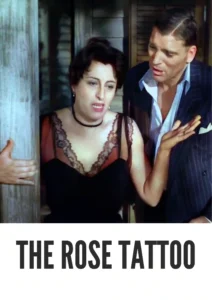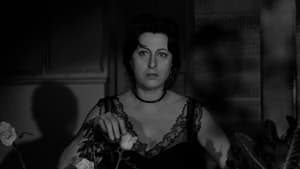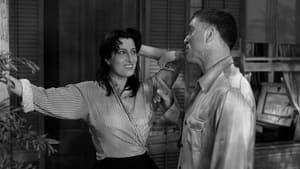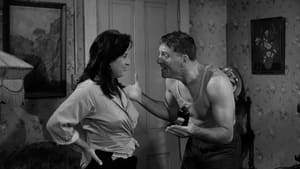Video Sources 0 Views
- Watch trailer
- The Rose Tattoo 1955 Colorized


Synopsis
Table of Contents
Toggle
Step into the passionate world of Tennessee Williams with The Rose Tattoo, a poignant and vibrant drama from 1955, now beautifully colorized for a captivating viewing experience. This film, based on Williams’ play, explores themes of love, loss, and the resilience of the human spirit in a close-knit Sicilian-American community. Starring Anna Magnani in an Oscar-winning performance, alongside Burt Lancaster, this HD download brings a timeless story of self-discovery and renewal to your screen. Perfect for fans of classic dramas and those who appreciate powerful performances, this colorized version offers a fresh perspective on a beloved cinematic treasure.
The Rose Tattoo tells the story of Serafina Delle Rose (Anna Magnani), a passionate and devoted Sicilian-American widow living on the Gulf Coast. Deeply in love with her truck driver husband, Rosario, Serafina’s world shatters when she learns of his death and his infidelity.
Devastated and disillusioned, Serafina withdraws from the world, isolating herself and her teenage daughter, Rosa (Marisa Pavan). Consumed by grief and suspicion, she clings to the memory of her husband, refusing to let go of the past. However, her life takes an unexpected turn when she meets Alvaro Mangiacavallo (Burt Lancaster), another truck driver who bears a striking resemblance to her late husband. Initially resistant, Serafina gradually opens her heart to Alvaro, rediscovering her own sensuality and zest for life.
As Serafina confronts her past and embraces the possibility of a new love, she also helps her daughter Rosa navigate her own romantic awakening. The film explores the complexities of love, grief, and the challenges of starting over, set against the backdrop of a vibrant and close-knit Italian-American community. Ultimately, The Rose Tattoo is a celebration of life, passion, and the transformative power of love.
The film features a stellar cast of actors who bring these complex characters to life:
-
Anna Magnani as Serafina Delle Rose
-
Burt Lancaster as Alvaro Mangiacavallo
-
Marisa Pavan as Rosa Delle Rose
-
Ben Cooper as Jack Hunter
-
Virginia Grey as Estelle Hohengarten
The Rose Tattoo falls into the genre of romantic drama, with elements of comedy and social commentary that are characteristic of Tennessee Williams’ work. Its exploration of human emotions and relationships, combined with its vibrant setting, makes it a captivating and engaging film.
Released in 1955, The Rose Tattoo reflects the changing social and cultural landscape of post-war America. Based on Tennessee Williams’ play of the same name, the film explores themes of female sexuality, cultural identity, and the challenges of assimilation. The film was produced during a period when Hollywood was beginning to push boundaries and explore more complex and controversial subjects. While The Rose Tattoo faced some censorship challenges due to its frank depiction of sexuality, it was ultimately a critical and commercial success, cementing Williams’ reputation as one of America’s leading playwrights and screenwriters.
This colorized version of The Rose Tattoo has been meticulously restored using modern digital techniques, enhancing the visual appeal while preserving the film’s original atmosphere of passion and emotion. The colorization process involved carefully analyzing the grayscale tones of the original black and white footage and assigning appropriate colors to each scene. This painstaking process brings new life to the characters and settings, making the story even more engaging for modern audiences. While some may debate the merits of colorizing classic films, it introduces these films to a broader audience, ensuring their legacy for future generations.
-
: Daniel Mann
-
: Tennessee Williams
-
: the play The Rose Tattoo by Tennessee Williams
-
: James Wong Howe
-
: Warren Low
-
: Hal Wallis Productions
-
: Paramount Pictures
-
: 117 minutes
-
: MP4
-
: HD (1080p)
-
: Compatible with most devices, including smartphones, tablets, computers, and smart TVs.
The Rose Tattoo (1955) is widely regarded as a masterpiece of American cinema, showcasing the talents of Tennessee Williams and the extraordinary performance of Anna Magnani. The film was nominated for eight Academy Awards, with Magnani winning Best Actress for her portrayal of Serafina Delle Rose. The film’s exploration of love, loss, and the resilience of the human spirit continues to resonate with audiences today. As a powerful and moving adaptation of Williams’ play, The Rose Tattoo remains a timeless classic.
-
: What is The Rose Tattoo about?
-
A: The Rose Tattoo is a romantic drama about a widow who finds new love after the death of her husband.
-
-
: Is Anna Magnani’s performance in The Rose Tattoo highly regarded?
-
A: Yes, Anna Magnani won an Academy Award for Best Actress for her performance in the film.
-
-
: Is this version of The Rose Tattoo colorized?
-
A: Yes, this version has been professionally colorized to enhance the viewing experience.
-
-
: What themes does The Rose Tattoo explore?
-
A: The Rose Tattoo explores themes of love, loss, grief, female sexuality, and cultural identity.
-
-
: What is the download format?
-
A: The download format is MP4, which is compatible with most devices.
-
-
: What resolution is the download?
-
A: The resolution is HD (1080p), providing a high-quality viewing experience.
-
Watch The Rose Tattoo Today!















